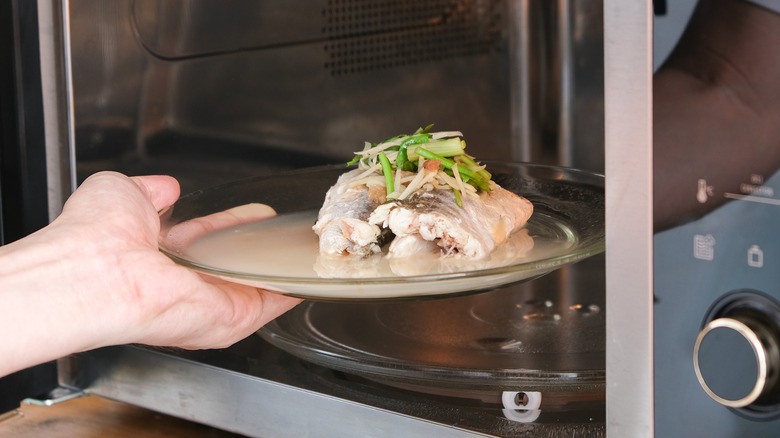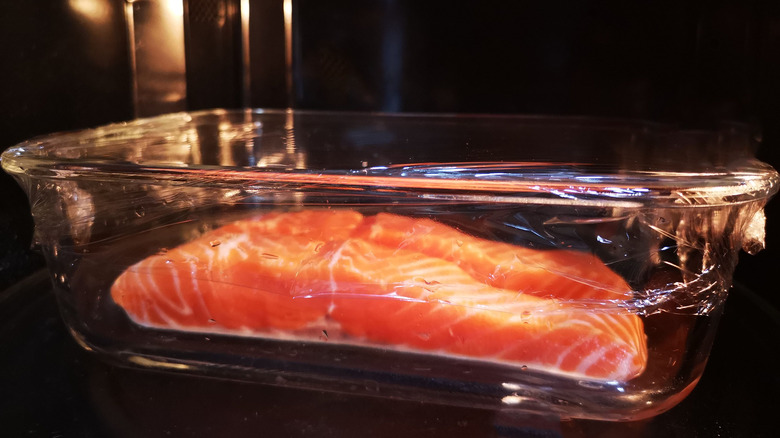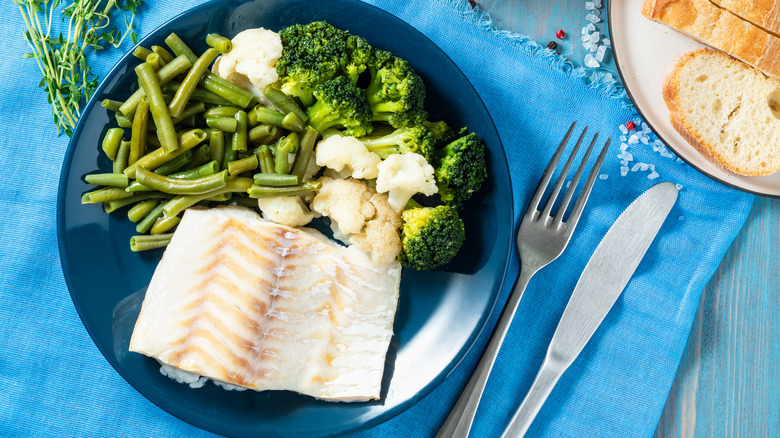Can And Should You Cook Fish In The Microwave?
It turns out your microwave is not just for nuking leftovers: You can also prepare a perfectly flaky fish fillet in this convenient appliance, and in a matter of minutes, to boot. As long as you're fine with a potential lingering smell in your kitchen, you can and should cook fish in the microwave.
There are a few benefits to using the microwave for fish. Not only is it faster than most other methods, but you can get away with using no cooking fat. The microwave is a wet heat cooking method, as opposed to a dry heat method like an oven. The appliance works by making water molecules inside food furiously vibrate, creating friction and heat. Since fish contains plenty of water (and you can even add extra liquid for flavor), those the electromagnetic waves essentially steam the fish, eliminating the need for fat to transfer heat to the flesh and prevent sticking.
According to the Food and Drug Administration (FDA), fish may even retain more nutrients when cooked in the microwave. Microwaves generally operate at a lower temperature than an oven or stovetop, which could keep more of the fish's omega-3 fatty acids intact. With a faster cook time, potential health benefits, and less dishes to dirty, cooking fish in the microwave is a super easy option for getting dinner on the table.
Tips for cooking fish in the microwave
You can use a non-metal, microwave-safe steamer basket to cook your fish, or simply place the fillet in a shallow dish. Loosely covering the dish can help to trap in the fish's moisture, while also containing some of the fishy smell that would otherwise permeate the room. Parchment or wax paper, a silicone lid, or microwave-safe plastic wrap will all work.
The time it takes to microwave fish depends on the size and thickness of the piece, as well as the type of fish and wattage of the machine. Most fish fillets will reach doneness in three to seven minutes. One thing to keep in mind is that microwaved fish will turn out soft and moist, similar to a poached preparation or salmon en papillote, so don't expect a crispy and seared outcome. No matter how you cook it, overdone fish is always dry, rubbery, and unpleasant, so microwave it for a relatively short time at first, adding extra 30-second intervals if needed.
Food safety still applies to cooking in the microwave, so use a thermometer to test the fish once it looks done. Fish should reach an internal temperature of 145 degrees Fahrenheit, per the United States Department of Agriculture (USDA). Allowing the fillet to rest for a minute or so will help it retain its juiciness, and once you cut into it, properly cooked fish should be opaque and flaky throughout.
What fish is best for microwaving?
While you can cook pretty much any kind of fish in the microwave, so long as you follow basic safety procedures, some choices turn out better than others. Oilier and firmer fish, such as swordfish and mackerel, aren't well-suited for steaming, so they won't fare the best in the microwave either. Thicker, leaner cuts of fish, like salmon and halibut, are perfect for zapping.
Most mild white fish also cooks up well in the microwave, and the appliance can also be used to steam shellfish — again, starting with less time and adding more if needed, to avoid having to fix your overcooked shrimp or scallops. Microwaving fish straight from a frozen state is also doable. Instead of cooking it for longer, you can increase the power setting on your appliance and cook the fish for the same amount of time as you would for fresh.
Fish contains enough water to steam on its own in the microwave, but adding more moisture is a solid way to infuse more flavor into your meal. Add a bit of wine, stock, or anything beyond plain water to the cooking vessel so it can seep into the fish and keep it moist. Celebrity chef David Chang's method of cooking salmon in the microwave involves using soy sauce and agave nectar for a flavorful moisture boost.



